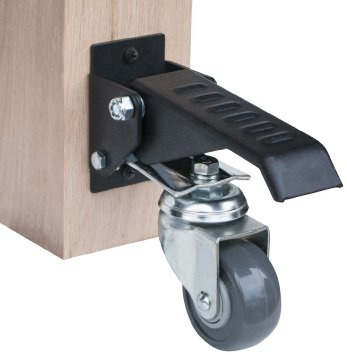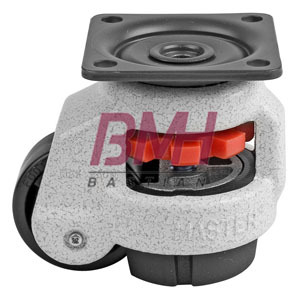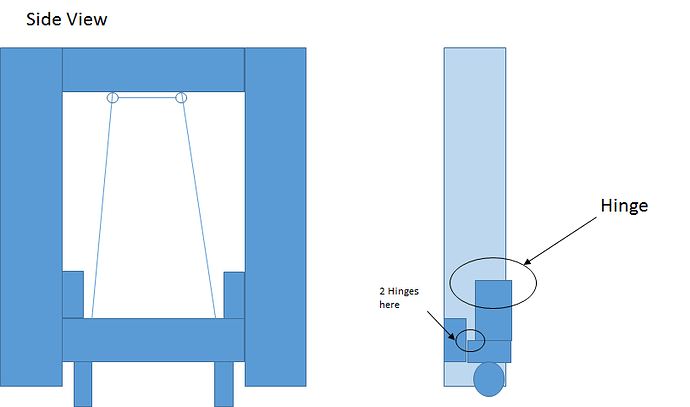One of our own forum members @iliketomakestuff recently posted a video on how to make a cart for his lathe. This can easily be used as a great guide to make a cart for your glowforge. If you replace the dust collection top with the sound dampener I posted earlier (Sound Dampening Table Top for your Glowforge), youll have yourself a pretty sweet custom spot for your new laser! (make sure you have some sort of locking casters to prevent wobble!)
I would be worried about wobble even with locking casters. The lathe probably doesn’t have large masses moving linearly in an unpredictable fashion, but for applications like the Glowforge I would probably put on some floor locks in addition to the wheels: http://www.castersupply.com/NAV/store_floorlocks.htm
I agree! There are a number of casters that have something similar built in so the wheels no longer make contact with the floor.
This is a great simple cart. While it would be a little strange, maybe only put three casters on the cart to help keep it from rocking in case the cart or floor are not level. The Glowforge is not nearly as heavy as his lathe.
I was thinking the same thing (that it could easily be adapted for the Glowforge) when I watched this video recently. I think it’s a great quick functional design that could be easily dressed up a little.
Just because I’m cheap I went the route of two locking casters at one end and legs all the way to the floor on the other. I’ll just lift up the leg end of the table to move it around. I did start with 4 casters and wasn’t happy with the movement. The lathe could potentially have a large mass. My lathe table is very heavy for that reason. Anytime you put a bowl blank on the lathe it starts out creating some very large vibrations. Anything smaller than 4" around and not much mass to worry about.
The main concern I have with anything wheeled is that the momentum of the head will cause the whole cart to rock and potentially shift materials or worse. That’s why I don’t use wheels on any of my CNC machine stations, but if I did I would make sure that I couldn’t move it without a struggle when locked.
My thoughts exactly – I think I would prefer to have a little more difficulty moving it around so that it stays put during use.
I agree, this could be a problem and for me one of my primary locations for the GF will be on a wood floor, so I’ve been thinking about wheel cups, like these to prevent movement or damage to the floor.

I’m with ya. I’d have to… casterate the cart.
I like it!
It’s the best of both worlds, a caster for easy movement that will allow the table or cart to sit back on its own legs. The only disadvantage I see will be the caster sticking out the side of the cart that could be a trip hazard or something to gam your toe into.
For heavier duty benches or machine bases, leveling casters, like these by Footmaster are pretty darn good. They can be had up to pretty large capacity (1100 lbs/caster or more) and the ratchet style leveling mechanisms are pretty easy to use and quick to raise or lower. I put them on 1100-lb and 1600-lb machine tools and they work great. A bench for the GF could probably get by with one of their lighter-duty caster models.
So I have looked into this a few times since ordering the glowforge. One thing to be aware of is the difference between braking casters, locking casters, and also the fact that a lot of manufacturers label braking casters as locking casters.
see also:

From Bastian Solutions
and don’t forget about floor-locks.
On one of my workbenches I came up with a solution (I don’t know if I “invented” it or saw it many moons ago and “remembered” it).
So, Kind of difficult to explain, when I get home I’ll try and post a sketchup file that explains it much better.
- 2x4 parallel to the floor is attached with 2 hinges to the vertical 2x4(or 2x6) so that when “open” it will only go from vertical to horizontal (Casters mounted to the bottom of this piece)
- It is held open by two blocks mounted on the legs also on hinges
- The Casters retract when you lift the table and pull on a string that is attached to both blocks, raising them to allow the piece with the casters to “flip” up to vertical and now you set the table back on it’s legs
REALLY don’t like my explanation, but it’s the best I can do until I get home and give you a MUCH better visual of what is going on.
beauty of this design is that the only hardware necessary is:
- 8 hinges (I’ve grabbed door hinges over the years, and those are overkill)
- 8 eyelets (doesn’t need to be beefy at all)
- 4 casters (non-locking is fine, would suggest swivel though)
- 2 pieces of wood the width of your table (2x4 or 2x6 fine)
- 4 pieces of 2"x4"x4-6" blocks
Many of us have all these on hand. If you don’t, you can buy almost whatever caster you want (doesn’t have to be locking, braking, or anything else), it just has to be able to handle your table fully loaded (weight). I’ve got casters that hold 150lbs each and I think it is a bit overkill.
yay cheap!
I really like how compact these are. The only issue I have is the same issue I have with the recliners in my volkswagen. Instead of a quick release to set my angle of reclination, I have to turn that knob which takes forever. I guess its a tradeoff. I like them though…
You could make a wrench (lasered out of acrylic) that would wrap around that black base and have tabs that fit into the notches. Then you’d have leverage to rapidly turn it. If you put a 3/8# square hole in it you can use a ratchet on it like a crows-foot wrench.
I have those on my X-Carve table I built.
nice, whats your opinion of them? do they work well? do you find yourself tripping on them ever?


